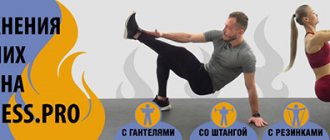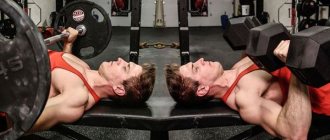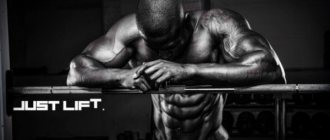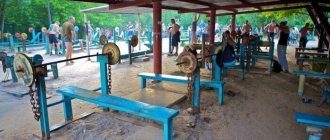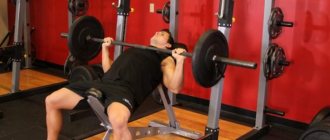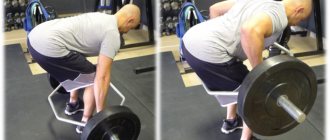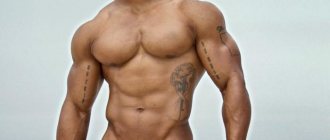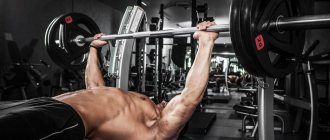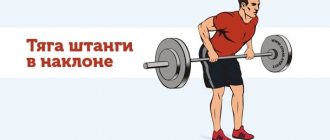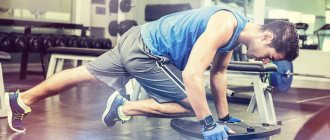Author: Timko Ilya - the ruler of the entire site and fitness trainer | more details >> Rod. 1984 Trained since 1999 Trained since 2007. Author and creator of the site tvoytrener.com. CCM in powerlifting. Champion of Russia and South Russia according to AWPC. Champion of the Krasnodar region according to IPF. 1st category in weightlifting. 2-time winner of the Krasnodar Territory championship in t/a. Author of more than 700 articles on fitness and amateur athletics. Author and co-author of 5 books.
Place in the ranking of authors:
out of competition
(become an author)
Date:
2012-05-29
Views:
727,071
Rating:
5.0
| All articles by the author >> | Medals articles >> |
Articles are loading...
| Article medals: | article in TOP 100 | more than 500 thousand views |
Why medals are given to articles:
| Bronze medal: | |
| 1. The article is in the TOP 100 2. The article has more than 3. The article has more than 100 | |
| Silver medal: | |
| 1. The article is in the TOP 50 2. The article has more than 3. The article has more than 500 | |
| Gold medal: | |
| 1. The article is in the TOP 10 2. The article has more than 1 3. The article has more than 1,000 | |
Primary muscles - iliopsoas Additional - rectus abdominis Difficulty - medium
Training
It is impossible to simultaneously use all the muscles that make up the abs in one exercise. Therefore, it is conventionally divided into upper, lower and lateral.
Working through each of these parts will require you to perform your own movements during classes. The number of repetitions in an approach depends on the initial training and characteristics of the body. As a rule, the first 2-3 workouts are introductory: excessive activity in them will not give anything except pain and stiffness in the muscles.
But the following classes are recommended to be carried out in the mode of three approaches, containing several repetitions of each exercise. To get visible results relatively quickly, you must always work to the limit of your capabilities. Therefore, it is necessary to gradually increase the number of repetitions without changing the number of approaches.
So, exercise options for the upper abs:
- Lie on your back, put your hands behind your head. Secure your straight legs by clinging to the edge of the furniture. Raise your torso to a sitting position. If the exercise is too difficult, you can bend your legs at the knees.
- The starting position is similar. Raise only the upper part of the body by 20-30 degrees, pressing your lower back firmly to the floor.
- Choose a comfortable inclination angle on the press bench. Take the starting position by hooking your feet on the ledges and clasping your hands behind your head. Raise your torso, trying to reach your chest with your hips. Over time, increase the inclination of the bench, increasing the range of motion.
Tasks that allow you to develop your lateral press:
- Lie on your back, clasp your hands at the back of your head, bend your knees. Raise your torso and legs at the same time, trying to reach the opposite knee with your elbow. The hip line should not go beyond the imaginary perpendicular to the floor.
- The starting pose is the same as in the previous exercise. Raise your bent legs and then lower them to the right, trying to touch the floor with your knee. Then repeat the same thing, turning to the left. The shoulder blades should remain motionless.
The lower abs are the most capricious. Pumping it up is quite difficult, but the following steps can help:
- Familiar from school “scissors”. Lie on your back, place your arms along your body. Raise your legs 30 degrees above the floor and perform “cutting” swings.
- Using statics. The starting position repeats the previous description. Raise your legs above the floor quite a bit and freeze in this position. The longer you can hold on without relaxing, the better.
- Hang on a wall bars or horizontal bar. Raise your bent knees to your chest. Over time, you can make the task more difficult by straightening your legs.
You can perform all the exercises in a row, or only selected ones. If the question is how to quickly pump up your abs at home, you should not only do all the movements described above, but also work with weights.
So, you can work on yourself at home. You just need to organize everything correctly and create your own set of exercises. Of course, this will take a lot of time, but the reward will be multifaceted pleasure. It will bring not only the favor of representatives of the opposite sex, but also new sensations associated with the ability to move more confidently.
Bulgarian split squat for legs
Another exercise on a bench with dumbbells (photo below), which targets the calves. To perform it, you will need to lower the bench to a horizontal position and take a really large load. The whole peculiarity of training is that the more effort an athlete makes to stand up, the sooner he will be able to build muscle mass. So 4-5 squats will be very effective.
- We take two dumbbells with a maximum load in our hands.
- We put one foot on the bench and put the other one slightly forward.
- We perform squats on the leg so that the knee touches the floor
- We get up with a sharp movement and repeat the actions until tired.
The main difficulty is keeping your back straight. Most novice athletes begin to lean their entire body forward, as a result of which the main load falls on the back, and not on the leg. To prevent this, try asking one of your friends for backup. Over time, you will learn to maintain an even position. Well, or you can practice a little with a small load, but muscle growth in this case will be very slow.
Training program
To make your classes as effective as possible, you need to create a training program and follow the advice of professionals.
- When including abdominal exercises in your overall training program, you should put them at the very end, after cardio and strength training.
- The ideal load is 3 sets. Men: beginners - 15 times, advanced - 20. Women: beginners - 10, advanced - 15. The numbers can be adjusted depending on individual physical fitness.
- Frequency - up to 3 times a week.
- Alternate between different types of exercises to evenly train all abdominal muscle groups.
- Gradually increase the number of repetitions and reduce the rest time between sets.
Sample training program for a month
Includes inclusion in the general training program. Physical fitness level is advanced. But classes can be adapted for both beginners and girls if you reduce the number of repetitions and increase the rest time between approaches. At first, you can exercise 2 times a week to give muscles that are not accustomed to such loads more time to recover.
Raising the body with dumbbells
Have you been looking for an exercise with dumbbells on a bench for a long time? Then you've come to the right place. With the help of the workout, the algorithm for which is described below, you will be able to pump up your abs without any problems. Moreover, this will not take too much time. The most important thing is to perform all the described actions exactly and gradually increase the load by adding weight and increasing the angle of inclination on the bench.
- Place the bench in a horizontal position.
- We take a heavy projectile in our hands and place it near our chest.
- We begin to perform body lifts, as they do when swinging the press.
As soon as you start to feel that this exercise is not putting a lot of stress on your muscles, try increasing the angle of the bench by a few tens of degrees. The steeper the surface, the more difficult it will be to lift the body. And if in parallel with this you also increase the mass of the dumbbell, then performing this exercise will be even more difficult. Just don’t overdo it so you don’t have to take painkillers later.
Bodybuilding exercises for pumping up the abs in the gym in pictures
Before we consider abdominal exercises in the gym, let’s find out what it is responsible for?
The abdominal muscles (press) are located in the pelvic area and are responsible for bending the torso forward, bending to the side and are responsible for rotating the spine.
Abdominal training usually contains exercises that develop forward bending, rotation and twisting. Also, the abdominal muscles perform stabilizing tasks, i.e. with any physical activity, the load is redistributed from the lower part of the body to the upper part and vice versa.
Normal conditions for the functioning of the abdominal organs are ensured by the work of the abdominal muscles. There are different abdominal exercises for different parts of the abs. They are described in our pictures.
Exercises for the entire abs
This exercise works well on both the lower and upper abdominal muscles.
Curling the torso on the machine is necessary to fully work out the rectus abdominis muscles.
Twisting your torso on the floor primarily works the rectus abdominis muscles.
Vertical sit-ups are an excellent exercise for working the rectus abdominis muscles.
Ab exercises: upper abs
Incline sit-ups should be done with multiple repetitions. It develops all the abdominal muscles.
Twisting your torso with your lower legs on a bench places emphasis on the rectus abdominis muscles, and most of all on the upper parts.
sit-ups work the hip flexors and obliques, but primarily work the rectus abdominis.
Raising the body against the gymnastic wall works the rectus abdominis muscles and, to a lesser extent, the external and internal oblique abdominal muscles.
Ab exercises: lower abs
Incline leg raises work both the lower and upper abs.
Knee raises work the hip flexors, primarily the iliopsoas, and the rectus and oblique abdominal muscles - the lower parts of the abs are especially heavily loaded.
Hanging knee raises work: 1. Iliopsoas, rectus femoris muscles when lifting the legs to the horizontal. 2. The rectus abdominis and, to a lesser extent, the obliques when the knees move above the horizontal.
Ab exercises: obliques
This exercise works well on the external and internal oblique abdominal muscles.
Standing side bends focus on the oblique abdominal muscles, especially on the fold side, and also work the rectus abdominal muscles to a lesser extent.
Lateral raises on a Roman chair mainly work the rectus and oblique abdominal muscles on the side in which we bend.
15. Rotation of the torso while standing on the “Twist” simulator Rotation of the torso while standing on the “Twist” simulator primarily involves the external and internal oblique abdominal muscles, and the rectus abdominal muscles are also involved.
All of the described abdominal exercises in the gym are very effective. All of them are discussed in pictures, which is more visual and easier to understand.
What is a simulator
The abdominal bench is a machine for strength exercises. Thanks to it, the abdominal muscles are activated and the lumbar part of the back is strengthened. Regular training quickly forms the relief in combination with proper nutrition, mainly protein foods.
It looks like an ordinary bench, the angle of which can be adjusted. It has bolsters at the bottom to hold the legs. On it you can perform twisting, bending and extension of the torso, and pump up the lateral press.
The question arises, why can’t all these exercises be performed on a fitness mat? Exercising on a bench is many times more effective than usual, especially if you do it with a weight (plate, dumbbells, water bottle). Due to the adjustable angle of rotation of the exercise board, the entire abdominal area swings, and not just one local zone. If you do the same crunches on the floor, only the rectus abdominis muscles are used, and the bench also includes the obliques.
Effective exercises for the sides
12th exercise for abdominal press at home: Torso twists with a bar
Purpose: The exercise is intended mainly to develop the oblique abdominal muscles. It is performed without the use of any home exercise equipment; you only need dumbbells or an empty bar.
Technique: 1. Standing, legs apart, back straight. 2. Place the bar on the trapezius muscles, at the back of the deltoids, without pressing the bar too hard
3. Turn the torso from side to side, keeping the pelvis motionless.
*This exercise can also be performed while sitting on a bench, with your legs spread wide apart, keeping your hips still to direct the load only on the abdominal muscles. Nutrition: Protein bars
13th exercise for the abs and sides for girls: Standing side bends
Purpose: The exercise is intended for the oblique abdominal muscles, and to a lesser extent the rectus abdominis muscles.
Technique: 1. Standing, legs apart, one hand behind your head. The second one holds a dumbbell
2. Inhale and tilt your torso in the opposite direction from the dumbbell.
3. Return to starting position
Interesting: 5th
Nutrition: Protein shakes for muscle growth
*Do an equal number of repetitions of the exercise, changing hands with a dumbbell in each approach, without taking breaks.
Purpose: The exercise is intended to develop the oblique abdominal muscles, and to a lesser extent the rectus abdominis muscles.
Technique: 1. Lie sideways on a bench
2. Secure the feet under the bolsters, the body seems to be hanging in the air, the arms are behind the head or crossed in the air
3. Take a breath and lift your torso up, bending at the side.
4. Return to starting position
5. At the end of the movement, exhale
Nutrition: Protein for muscle gain
15th exercise for the abs and sides for girls: Rotation of the torso while standing on the “twist” machine
Purpose: The exercise primarily engages the external and internal oblique abdominal muscles, also involving the rectus abdominis muscles. Performed in a special weight loss machine
Technique: 1. Stand on a rotating stand. Grab the handles of the machine.
2. Rotate your pelvis from side to side, trying to keep your shoulders motionless throughout the exercise. Bend your knees slightly, shifting the center of support not to your toes, but to your heels, which should not be lifted from the stand during rotation.
* The best results can be obtained with frequent use and repeated repetitions of this exercise.
Useful exercises: 1) Exercises for the buttocks 2) Exercises with dumbbells in pictures 3) Exercises for the legs 4) Training program for weight loss 5) Kettlebell push 6) Kettlebell lift 7) Kettlebell snatch
Rules for performing abdominal exercises on a bench
An inclined bench for the press will allow you to achieve a beautiful relief of the abdominal muscles only if you strictly follow the recommendations developed by professional trainers specifically for this machine. Basic Rules:
- During exercise, constantly tense your abdominal muscles;
- do not lift your pelvis and lower back from the bench;
- perform the exercises smoothly, without jerking;
- the neck and spine should be a straight line;
- bend your body as you exhale, straighten as you inhale;
- When bending, round your back;
- gradually increase the load: change the inclination of the machine, use weights.
How to make it yourself
You can make a press bench with your own hands. This can be an outdoor board or for practicing at home.
How to make a street exercise machine (simple option):
- Dig two low posts into the ground with a crossbar between them at the desired height.
- Place 3-4 boards of the length you need fastened together on this crossbar.
How to make an exercise machine for exercising at home (simple option):
- Connect 3-4 narrow, well-finished boards of the required length together (this can be done with cross beams at the top, middle and bottom).
- Place them on one of the compartments of the home wall bars.
- Secure with a cross beam holding the boards together at the top.
Those who have the opportunity to get pipes and perform metal welding can make their own inclined bench with a backrest. The dimensions of the main elements and fastening diagrams are shown in the figures below.
Warm-up
You should maintain an hour-long gap between classes and meals. It is also better to try not to drink for at least 40 minutes after training, especially when it comes to losing weight. Lack of moisture will force the body to use up accumulated reserves, which means burning fat.
You should not start doing physical exercises abruptly, without preparation. First you need to warm up your muscles with a warm-up. An approximate set of movements is as follows:
- development of all joints by rotating clockwise and counterclockwise;
- bending forward and to the sides;
- activation of the neck muscles - head turns and nods;
- turns the body to the right and left;
- any stretching.
All these simple actions will help avoid injuries to tendons and joints, increase blood flow to the muscles, and improve coordination. Simply put, the task of exercise is to prepare the body for active movements. Too sudden a transition from rest to stress causes unnecessary stress, forcing all systems to work in emergency mode. Neglecting to warm up can worsen your overall health, lower your mood, and increase fatigue. As a result, the effectiveness of training will noticeably drop and you will have to wait longer for beautiful abs to appear.
Twisting on an incline bench, execution technique and video
To get a beautiful waist and firm stomach, you won’t be able to get by with training just the core abdominal muscle. It is also necessary to pump up the oblique abdominal muscles, in this article we will look at how to do this? You will also learn several types of crunches on the bench.
Crunches on a Roman bench
The Roman bench is designed to pump up the abs well; you can use it to perform many exercises, but its initial purpose is crunches to pump up the oblique muscles of the abdomen and the entire abs. Let’s say that when performing crunches on the floor, only the upper part of the abdominal muscle is involved in the work. The exercise machine makes it possible to distribute the load over the entire abdominal area.
The abdominal muscles are of great benefit in bodybuilding; the stronger they are, the less load is placed on the spine when performing basic exercises. They also serve as stabilizers and aids in maintaining balance while working with a barbell.
Working on a Roman bench does not imply the use of additional weights; the athlete performs the work with his own weight. Therefore, it is easy and convenient to dry and do exercises with a large number of repetitions.
If the exercise is performed incorrectly - twisting on a bench - the joints may be involved in the work, we should not allow this. When performing crunches on a Roman bench, the entire abdominal area is loaded, but its lower part, due to its anatomical location, does not experience the same load as the top.
To pump it up, we recommend raising your legs up. But remember about the joints; if performed incorrectly due to the load on the joints, the Roman bench can cause harm to the spine. This happens if the athlete bends strongly downwards while performing the exercise.
At this lowest point, the entire load will be transferred to the spine and oblique muscles of the back.
Read on the topic Crunching on a block (press)
Step-by-step execution technique
- You need to lie on a Roman bench, the body is well fixed and the legs are hooked to special fastenings.
- Lower your body as low as possible, but the abdominal muscles should hold it at the very bottom; you need to calculate the peak point of contraction.
- Rising from the starting position, it is easy to calculate - at the very beginning the abs are most tense.
- Lifting must also be carried out carefully; it is not allowed to fall too much. The press at the top point should be contracted - not relaxed.
- The lowering of the hull must be carried out more slowly than the ascent.
- If you do not have sufficient experience, we do not recommend performing exercises with additional weights, in which case the entire load will be transferred to the back.
Video:
The principle of execution, oblique crunches on the press on a bench, is identical to the standard one, only at the top point you slightly turn the body to the side, repeat in one and repeat in the other. The position of the hands during execution has also been slightly changed.
Step-by-step execution technique
- Having firmly hooked your feet to the stands, we lie down on the bench.
- Starting position: place one hand on the back of your head, the other resting on your upper thigh.
- When lifting, we evenly twist the torso to the left side.
- You need to twist until your right elbow touches your left knee.
- When lifting, we recommend pausing for a second, always keeping your abdominal muscles tense.
- Then exhale and slowly lower the body down.
- After completing the required amount, change the position of your hands and change the direction of the turns.
Reverse crunches on an incline bench
This variation of crunches trains the obliques, upper and lower abdominal muscles. The exercise is performed as follows - you do not lift your torso, but lie down on the contrary and work with your legs.
Read on the topic Twisting with turns
Step-by-step execution technique
- Go to the bench, lie down on it and grab the leg rails with your hands.
- Bend your knees slightly and slowly begin lifting until your knees touch your chest.
- You can also perform leg lifts, which will involve the oblique muscles to a greater extent.
There is also a straight leg lift, which is a little harder.
Dumbbell bench press (incline)
The exercise is ideal for a person who wants to pump up their biceps in the shortest possible time. It’s worth noting right away that lifting dumbbells will be quite difficult, so you should take a light weight. As for the remaining nuances, just follow the algorithm of actions described below.
- We line up the bench at an angle of 45 degrees.
- Take a comfortable position, pressing your back tightly to the plane.
- We take dumbbells in our hands for a regular bench press (with plates facing the bench).
- With each inhalation, we lift the iron, turning it 90 degrees towards us.
- Your forearms should be parallel to the floor.
- The palms should face the athlete's face.
- Slowly extend your arm, lowering the dumbbells (without throwing them).
It is highly recommended to start performing this exercise with a large number of repetitions with a small weight. After several approaches (from 3 to 5), you can add a few plates to the iron and start doing fewer repetitions. The most important thing is to do the exercise as accurately as possible, as written above.
Effective exercises
Girls can’t start working out in the gym or at home to build beautiful abs right away after giving birth.
It is important to wait 2-3 months to allow the body to regain its strength. After a caesarean section, the first abdominal exercise is permissible no earlier than six months later
All other categories of people can start training immediately, but after consulting a doctor.
Features of home training
If you train at home, then you should learn certain exercises to pump up your abs. We offer the most common options with photos and detailed descriptions of the equipment:
"Scissors"
The movement must be performed without straining the lower back, so it is important to keep it pressed tightly to the floor. You should lie down on a gymnastic mat, stretch your arms along your body, lift your straight legs off the floor and hold them at an angle of 30-45 degrees.
Then make swings overlapping each other, as if cutting with scissors. Perform for 1-3 minutes.
Plank. A static exercise that allows you to work and strengthen all muscle groups. You need to take a lying position, then bend your arms and rest on your forearms. The entire body should be elongated in one line. Hold the position for 1 minute.
Leg raises (reverse crunches). The starting position is the same as in the scissors exercise, but the trajectory of movement is different. It is necessary to raise your legs so that the angle between your torso and hips is 90 degrees. When raising your legs, fix your lower back and back, perform the movement only using the strength of the abdominal wall muscles. We perform 2-3 sets of 20 repetitions.
Twisting on the floor. This is a classic abdominal exercise. You need to lie with your back on the floor, move your legs towards your butt, and put your hands behind your head. We lift our shoulders and upper body off the floor and stretch our chest toward our knees. You can pump up your abs in this way in a comprehensive workout.
You can also follow the table, which indicates how many times you need to pump your abs a day in order to pump up your abdominal muscles with just this exercise.
Wheel exercises. A roller is a simple and inexpensive sports equipment for home training. It is a wheel with handles on the sides. To use it to work the muscles of the abdominal wall, you need to kneel down, grab the handles of the roller with your hands and move forward as much as possible, then return back.
Fitball training. With the help of a gymnastic ball, you can pump up any muscle group, the abs are no exception. You can perform classic and reverse crunches, as well as a number of other exercises. Let's consider the standard option. You should sit on the ball and roll it so that it is under your lower back. Feet rest on the floor, arms folded on the chest. We lift our shoulders and stretch forward, then return to the starting position. The ball will help you work without straining your lower back.
Working out at a sports club
In the gym you can work out your abs using exercise machines. Such classes are suitable for more experienced athletes.
The ideal solution for pumping up your abs would be the following classes:
On the uneven bars. You can stand on straight arms or focus on your forearms. Let's consider the technique according to the first option. We stand on the uneven bars with straight arms, slightly tilting our head and chest forward. We raise our legs parallel to the bars, then lower them. We do 3 sets of 10-15 times.
On the wall bars. As an option - on the crossbar. You need to grab the horizontal bar with your hands, then pull your legs bent at the knees towards your stomach. This will work the rectus abdominal muscles. You can quickly pump up your lateral muscles if you alternately turn them to the right and then to the left when lifting. The exercise should be performed 3 sets of 15-20 repetitions.
On a Roman chair. To pump up your abs on an inclined board, you should sit on it and fix your legs with bolsters. Next, we place our hands behind our heads and lean back, keeping our back rounded. You should not lie down completely on the bench. We perform 3 sets of crunches of 20 repetitions.
We hope our recommendations will be useful to you during abdominal training. We sincerely wish you good luck and a great mood. If the article turned out to be useful and interesting, tell your friends about it through social networks. Thanks in advance, and see you again!
2+
(No ratings yet)
https://youtu.be/2shI3TldERc
Delta swings at a 45 degree inclination
For this exercise with dumbbells on a bench, you will need to use a device that can change the angle of inclination. But the effectiveness of such training will be noticeable almost immediately. Even professional bodybuilders often use them to pump up this muscle group. The difficulty lies only in choosing the optimal weight of the projectile, since with dumbbells that are too heavy there is a chance of making several mistakes.
- We set the bench at an angle of 45 degrees.
- We lie flat on our chest and take dumbbells in our hands.
- We direct our palms inward, taking the starting position.
- We spread our limbs to the sides without bending our elbows.
- Slowly return to the starting position.
The main mistake novice bodybuilders make is that they bend their elbows, as a result of which a completely different muscle group is tensed during the exercise. In most cases, this happens precisely because the athlete has chosen the wrong weight of the projectile. So perform exercises with those dumbbells that will allow you to perform it as efficiently as possible. Muscle tension in this case does not play too big a role.
